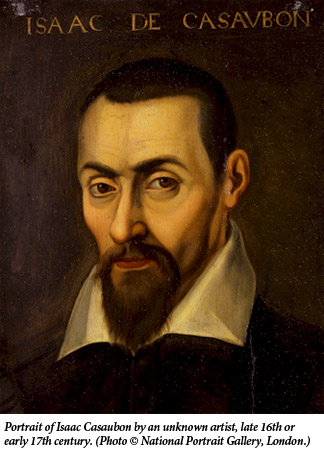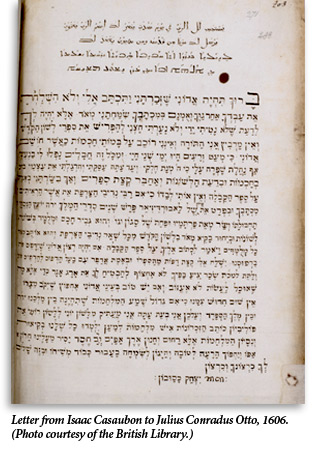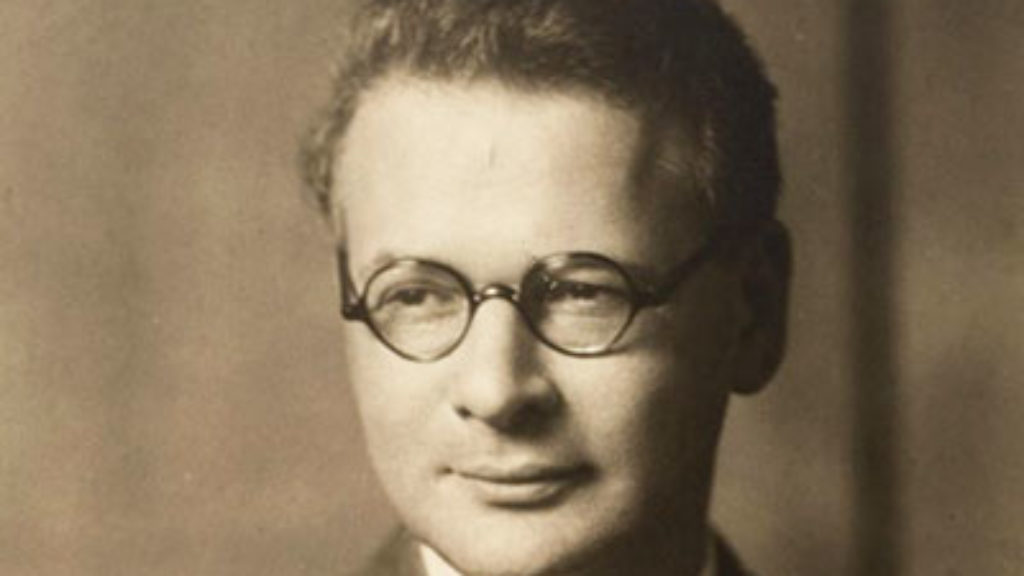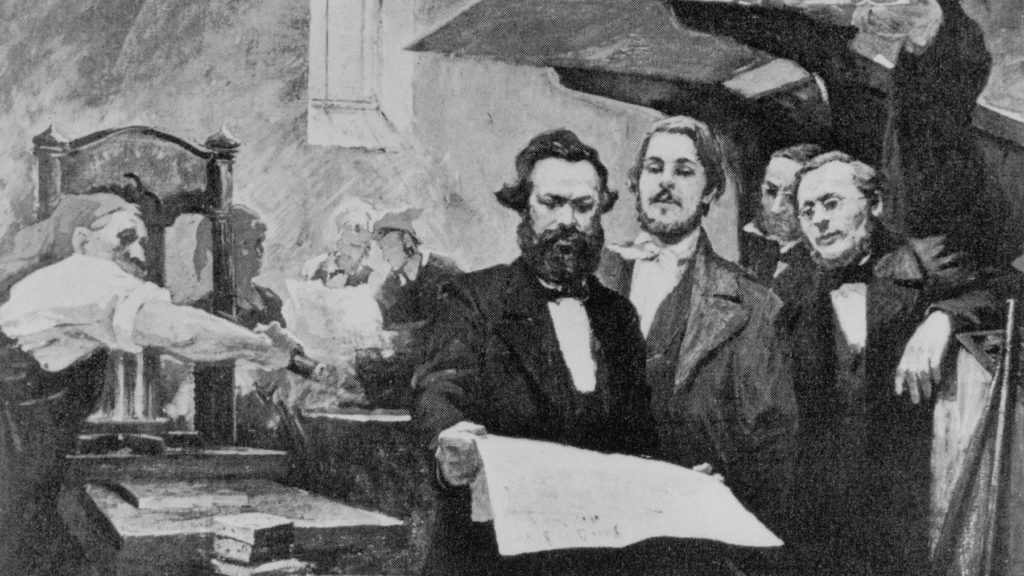The Man’s Learning Moves Me
Early in the introduction to their fascinating new study of the 16th-century French Huguenot classicist, Isaac Casaubon, Anthony Grafton and Joanna Weinberg offer a characteristically witty account of their subject’s astonishing fertility. “Casaubon produced seventeen children,” they write, “as well as a vast stream of learned works, some of which he wrote while using one foot to rock the current infant’s cradle.” The picture they paint is both humanizing and reminiscent of a description I once heard of a young Anthony Grafton pacing the streets of Princeton, head down, reading a hefty tome, with a small child tucked under his beard in a sling strapped to his chest.
Grafton and Weinberg have both made essential contributions to the intellectual history of Isaac Casaubon’s period. They are also the leading experts on two early modern scholars in whom Casaubon himself took an abiding interest: Grafton having written the authoritative treatment of Joseph Scaliger, and Weinberg having almost single-handedly recovered the crucial importance of Azariah de’ Rossi. In fact, Grafton and Weinberg are not unlike Casaubon, using textual traces and literary record—books, letters, and especially marginalia—to reconstruct interior thinking, relationships, and habits of mind through exquisite and precise attention to detail coupled with a sympathetic imagination—identification, really—with their subject. What Grafton and Weinberg appear to have found in Isaac Casaubon is a kindred spirit, a humanist whose scholarly pursuits might have occasionally bordered on the obsessive, but who never immersed himself so deeply in that world that he stopped rocking the cradle.
 This is not the first book-length treatment of Isaac Casaubon’s life and work. Mark Pattison’s biography of Casaubon, which first appeared in 1875, offered a portrait of a compulsive, ascetic, and intellectually (not to mention physically) desiccated scholar who very nearly read and wrote himself to death, poring over thousands of pages of classical materials that chained him to the past. Pattison’s Casaubon sounded like his famous fictional namesake, the Reverend Edward Casaubon, whose obsessive search for the “key to all mythologies” in George Eliot’s Middlemarch (published a year before Pattison’s biography) produced one of the most unsatisfying and loveless marriages in Victorian literature. Grafton and Weinberg are generous with their praise for Pattison’s biography, even as they are critical of its view of their subject.
This is not the first book-length treatment of Isaac Casaubon’s life and work. Mark Pattison’s biography of Casaubon, which first appeared in 1875, offered a portrait of a compulsive, ascetic, and intellectually (not to mention physically) desiccated scholar who very nearly read and wrote himself to death, poring over thousands of pages of classical materials that chained him to the past. Pattison’s Casaubon sounded like his famous fictional namesake, the Reverend Edward Casaubon, whose obsessive search for the “key to all mythologies” in George Eliot’s Middlemarch (published a year before Pattison’s biography) produced one of the most unsatisfying and loveless marriages in Victorian literature. Grafton and Weinberg are generous with their praise for Pattison’s biography, even as they are critical of its view of their subject.
Grafton and Weinberg position their book in one of Pattison’s blind spots, visible only now thanks to more recent developments in Renaissance intellectual history. They brilliantly build upon the many rich new studies of the last several decades that have uncovered the essential role played by Christian Hebraism—the study of Hebrew and Jewish texts by Christian scholars—in early modern philology, philosophy, historiography, theology, comparative religion, and even the natural sciences. Clearly indebted to the important recent scholarship on figures like Johann Buxtorf, the explicator of Jewish customs; Sebastian Münster, the Hebrew philologist; John Selden, the legal scholar; and others, what distinguishes Grafton and Weinberg’s assessment of Casaubon’s scholarly projects—and what marks it as the beginning of a new phase in the study of Christian Hebrais—is that Casaubon was very clearly not of the same caliber in the area of Hebrew study as these scholars. His knowledge of Hebraica was secondary and instrumental to his real expertise in Latin and Greek, particularly the Greek of the early Christian era.
What Casaubon knew of the Hebrew language and of Jewish writings he picked up intermittently, as opportunities presented themselves. To be sure, Casaubon’s Hebrew was far superior to that of the vast majority of his Christian contemporaries. But he conducted nothing like the systematic study of Jewish practices and rituals that Buxtorf had compiled, of the Hebrew language that Münster had produced, or of Jewish civil or marriage laws that Selden had assembled. Grafton and Weinberg’s reconstruction of Casaubon’s Hebrew and Judaic library reveals an idiosyncratic collection of texts, ranging from the essential, like Elijah Levita’s Grammatica Hebraica or Buxtorf’s Synagoga Iudaica, to the unusual, like several different Sephardic siddurim and machzorim. But there are also noteworthy gaps. He possessed no complete rabbinic Bible, very few midrashic or Talmudic books, and no Kabbalistic texts.
It is precisely because Casaubon was a second-tier Hebraist that Grafton and Weinberg’s recovery of his study of Hebraica, and its role in his larger intellectual project, is so important. If the last several decades have left little doubt that Christian Hebraism was a central feature of Renaissance thought, Grafton and Weinberg have now begun to show how this helps to illuminate and enlarge our appreciation of scholars and divines beyond the core group of specialists. It is certainly not the key to all mythologies, but Casaubon’s interest in Hebraic studies becomes, in the expert hands of Grafton and Weinberg, a means for appreciating how Hebraism shaped the philological, theological, and historiographical endeavors for which Casaubon was celebrated.
“I
Have Always Loved the Holy Tongue”—the title taken from one of Casaubon’s letters to Buxtorf in 1610—is a gorgeously produced volume; more importantly, it is accessibly written. I confess a combination of admiration and envy for the astonishing textual detective work on display. Casaubon and his scholarly peers in the Republic of Letters lived in the rarified polyglot atmosphere of Latin epistolography and Greek marginalia, but Grafton and Weinberg do not expect such linguistic expertise from their readers. They provide lucid, even lively, translations of all of their texts (with the originals down below in the footnotes for ambitious readers). The inclusion of a generous sampling of manuscript pages and annotated printed pages makes the discussions all the more tantalizing and alive, even as they frustrate the reader who lacks the capacity to make sense of what so often looks like the proverbial chicken scrawl. As we read his letters and notes with their help, we watch Casaubon, and by extension, Grafton and Weinberg, “thinking in a richly historical way about . . . ancient book[s].” Writing and reading seem to be how he connected with others, not just those in the past, but even in the present. Grafton and Weinberg repeatedly and plausibly refer to Joseph Scaliger, for example, as Casaubon’s best friend, even though the two appear never to have met in person.
It was his historical imagination, rooted in textual encounter, that was Casaubon’s great strength; but it also led to some particularly intriguing relationships with living Jews, two of whom are the subject of the book’s final chapter. Here Grafton and Weinberg undertake perhaps the most speculative task for any intellectual historian. It is one thing to reconstruct the development of an idea. It is yet another matter to use textual traces to reconstruct a set of human relations. Such a reconstruction is, however, especially important since it offers the reader a glimpse into how interdependent and integrated Casaubon’s religious beliefs, intellectual passions, and feelings for his subjects were. In a word, Grafton and Weinberg recover some of the human in this important humanist. Out of the texts and textures of correspondences and marginalia, they weave a pair of compelling stories. The first is about Casaubon’s relationship with a Jewish convert to Christianity, Julius Conradus Otto, who served as professor of Hebrew, Syriac, and Aramaic at the Altdorf Academy in Nuremberg. The exchange of letters between Casaubon and Otto, all composed in a stylized, formal, and formulaic Hebrew and written in strikingly beautiful, painstakingly printed, vocalized Hebrew letters, reveal a touching picture of a scholar hungry for access to new books and for instruction in Hebraica. Casaubon went out of his way to give the benefit of the doubt to Otto despite having been warned repeatedly by others who knew the convert better than he that his trust in Otto’s scholarly capacity to perform all the work he promised might not have been so well-founded.
 The disappointment Casaubon surely felt when Otto failed to live up to his promises of greater insight into Jewish mysticism (a subject about which Casaubon had persistent doubts) or improvements to the Hebrew version of the New Testament was scant, however, compared to the sense of betrayal he must have felt in his relationship with another Jew, Jacob Barnet. What we have known until now about Barnet has come primarily from accounts written by Englishmen, all of whom described a Jew of considerable erudition and charisma who had led his English hosts and sponsors to believe that he wished to convert to Christianity but who, at the last minute (celebratory sermons had even been prepared for the festive occasion), reneged on that promise and fled the scene. He was eventually caught and spent the next two months in prison before being released and exiled from England.
The disappointment Casaubon surely felt when Otto failed to live up to his promises of greater insight into Jewish mysticism (a subject about which Casaubon had persistent doubts) or improvements to the Hebrew version of the New Testament was scant, however, compared to the sense of betrayal he must have felt in his relationship with another Jew, Jacob Barnet. What we have known until now about Barnet has come primarily from accounts written by Englishmen, all of whom described a Jew of considerable erudition and charisma who had led his English hosts and sponsors to believe that he wished to convert to Christianity but who, at the last minute (celebratory sermons had even been prepared for the festive occasion), reneged on that promise and fled the scene. He was eventually caught and spent the next two months in prison before being released and exiled from England.
Late in life, Casaubon, the embattled Huguenot, appears to have found a church that followed his own sense of the middle path when he arrived in England in 1610 and became acquainted with King James I and representatives of the Church of England, including Lancelot Andrewes, with whom he developed a strong intellectual friendship. Casaubon, we now learn from Grafton and Weinberg, took more than a passing interest in Barnet during his sojourn in England, having hosted him personally for a period of time and having studied rabbinic texts rather intensively, if briefly, with him. Though they had parted ways some months before, Casaubon continued to follow Barnet’s career with considerable attention and was distressed, like most of his fellow Protestants, at the news of Barnet’s “apostasy.” Yet Casaubon’s disappointment took a different form than that of most, whose attacks on the general mendacity of Jews were as vitriolic as they were predictable. Although he could not sanction Barnet’s stubborn unwillingness to accept providential Christian salvation, Casaubon nevertheless saw in Barnet a man after his own heart, dedicated to a life of books and study. In one of several pleas he offered on Barnet’s behalf, Casaubon wrote directly of his sympathy for a fellow scholar: movet me tamen hominis eruditio (the man’s learning moves me).
Grafton and Weinberg’s final chapter vividly shows how Casaubon’s own readings, which were clearly undertaken with polemical and theological targets in mind, were informed by his encounters with these Jews, who tipped him off about useful passages in Jewish writings and how best to read them. Their learning did indeed move him in new directions. Among other things, they provided him with ammunition in what Grafton and Weinberg wryly characterize as “the longest book review, and one of the most negative, written in a polemical age,” his extended and unfinished critique of Cardinal Cesare Baronio’s tendentiously Catholic history of the church, Annales Ecclesiastici. But Jewish learning also moved him as a scholar, a rigorous thinker who could see a human face across a religious divide and feel a sense of empathy, even compassion.
Grafton and Weinberg have clearly been moved by their subject, too. They have been driven to important new insights into the role of Hebraic study in early modernity; and they have been moved by the commitment to learning, and a republic of humane letters, that they have recovered in Casaubon’s life and writings.
Suggested Reading

Shylock at the Barricades
The new production of The Merchant of Venice is both revolutionary and timely. It’s also deeply disappointing.

America’s Jewish Bridegroom
Horace Kallen can be found in the ill-starred pantheon of prolific writers known for only one thing: one novel, one sonnet, one treatise, or, in his case, one idea. That idea is “cultural pluralism.”

Karl Marx, Bourgeois Revolutionary
Jonathan Sperber's new biography paints Karl Marx as a surprisingly conventional 19th-century paterfamilias.
Translating and Remembering Chaim Grade
A memoir of faith, literature, and chickens.
Comments
You must log in to comment Log In